PDI moving to a newer building: How do you say farewell to your old home?
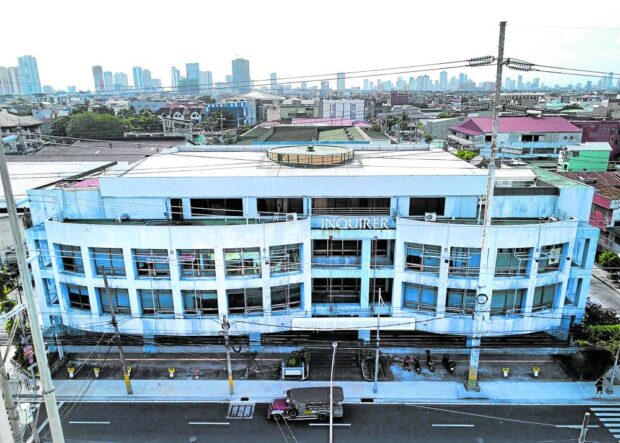
The Inquirer Building today (Photo by GRIG C. MONTEGRANDE / Philippine Daily Inquirer)
MANILA, Philippines — Like most essential news stories, people know the when, the who, the how, and the why of the Philippine Daily Inquirer.
It was founded in 1985 by, among others, publisher Eugenia “Eggie” Apostol as part of the so-called “mosquito press” that would prove instrumental in the subsequent Edsa People Power Revolution the year after.
After that, the Inquirer grew to become the broadsheet of record, embodying not only the “Balanced News, Fearless Views” in its tagline but a murderer’s row of writers of style and substance.
But amid all that, what people often overlook about the Inquirer story is the where.
The Inquirer found its first home in December 1985 at the Star Building on 14th and Railroad Streets in Port Area, Manila.
In June 1986, the Inquirer moved to the former building of Madrid Restaurant on Edsa in Mandaluyong City.
Inquirer pioneer and columnist Ceres Doyo recalls, “The ambiance was old-world grunge rather than shabby chic, what with dark labyrinthine corridors and musty carpets fraying at the edges. It was always smoke-filled because the smoking ban was not yet in place then.”
Article continues after this advertisementIn November 1987, the company decamped to BF Condominium Building in Intramuros; in December 1990 the Inquirer’s home was part of a warehouse in YIC Building in Ermita, Manila.
“YIC Building was a rickety old two-story structure that was waiting to be demolished and turned into a commercial place,” Doyo says.
Doyo says that word of mouth had it a permanent Inquirer Building was being built “somewhere in old Makati … Our itinerant life would soon be over, we thought, and we awaited our final move with wild expectancy. We were in for a surprise when we moved in December 1994.”
By this time, Marixi Rufino Prieto was now board chair and her daughter Sandy Prieto (later Romualdez) was president. Today, lawyer Rudyard Arbolado is president and CEO of the Inquirer, while Prieto-Romualdez is president of the Inquirer Group of Companies (IGC).
In January 1995, the Inquirer Building was inaugurated on 1098 Chino Roces Ave., occupying the block between Mascardo and Yague Streets, built by Pimentel Rodriguez Simbulan & Partners.
The Inquirer Building was a striking modern white-and-blue (Inquirer colors, of course) four-story building with a distinctive spiral staircase (that would be the spot for many a memorable photograph). The spacious building was state-of-the-art, and even its location was significant.
Brave heart
“More than the new Inquirer Building that gave us journalists a high was the fact the building was on the avenue named after the late Joaquin ‘Chino’ Roces, publisher, an icon in Philippine newspaper publishing and, in his later years, an activist, a street parliamentarian who risked life and limb to bring down the dictator and restore freedom of the press and other basic rights,” Doyo explains.
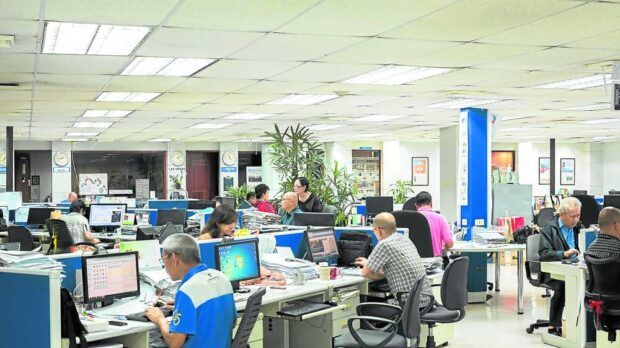
The busy Inquirer newsroom in 2015. (File photo by GRIG C. MONTEGRANDE / Philippine Daily Inquirer)
The Inquirer Building was the body, but its brain was publisher Isagani “Gani” Yambot. Mr. Y. was always hounding people to get the paper done on time and would not suffer any grammatical errors. Yambot, unfortunately, suffered a heart attack and passed away in 2012 at the age of 77.
“The well-liked Gani was … always on the lookout for grammatical and factual errors, and who was the Inquirer’s face during press freedom protests,” says Juliet Javellana.
The brave heart of the Inquirer was Letty Jimenez-Magsanoc (LJM), whose editorial leadership remained unafraid and undiminished throughout her stint as editor-in-chief from 1991 to her shocking death on Dec. 24, 2015, at the age of 74.
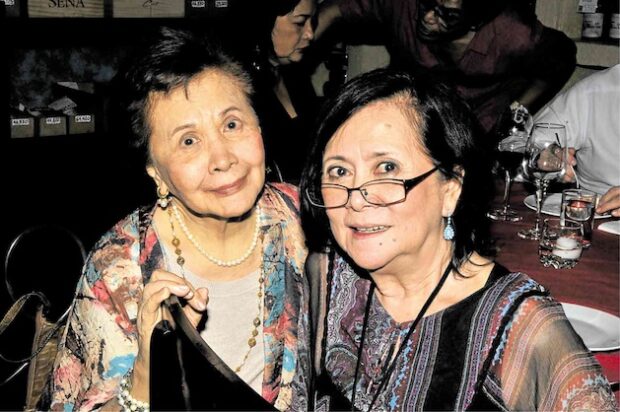
Inquirer founding chair Eggie Duran Apostol and editor in chief Letty Jimenez-Magsanoc (LJM) defined the paper’s feisty and courageous kind of journalism. (INQUIRER FILE PHOTO)
“The building, and the newsroom in particular, was a witness to so many good memories, especially LJM’s long reign in the newsroom,” adds Javellana. The morning after her death, stunned colleagues gathered in a silent newsroom. Her desk in the middle of the newsroom would remain unoccupied as a sign of respect and mourning for the rest of the building’s existence.
The Inquirer Building was a place where people started and often stayed. Javellana joined the Inquirer in 1989, as a supplement writer for the advertising department before becoming a reporter; she is now associate publisher after 34 years with the organization.
Joseph Voltaire “Volt” Contreras began as a proofreader and, after 30 years, is now the paper’s executive editor: “The building basically saw my professional growth and the coming and going of colleagues, including senior editors whom I consider to be my mentors.
“I was office-based as a supplement writer from ’95 to mid-’96 then again from 2007, when I joined the desk, and onwards.”
It has been a place of joy and surprise as well. The Inquirer Building has seen couples meet, break up or marry and have kids (talk about your “Inquirer babies”). It has been a place of growth.
Pam Pastor felt like she had grown up in the newsroom. She’s not wrong. She was still in college in 1998 when she saw an ad announcing a search for student correspondents for the Inquirer’s youth section. She applied — and was accepted.
“I felt like a kid surrounded by worldly adults — and that’s really what I was. But everyone was kind and welcoming. I was 17 when I first wrote for the Inquirer.”
Today, Pastor is, along with editing the youth section and Super, also assistant Lifestyle editor.
Major milestone
There are those who have known only the Inquirer as an employer.
As a journalism major at the University of the Philippines Diliman, Krixia Subingsubing was an Inquirer journalism scholar.
“I started working for the Inquirer in July 2016, first as an editorial production assistant before becoming a reporter in October 2017. Funnily enough, I always find myself at the Chino Roces building at every major milestone in my life,” the 27-year-old Subingsubing says.
On her being chosen as a scholar in 2014, she says: “[It’s] the first and only newsroom I have ever worked for — and the building is the only one I’ve ever considered my second home. It was where I met some of my closest friends now and the mentors who trusted I could be a journalist.”
Like a magnet, it drew her in: “Something was always happening at the office. Even when I became a reporter and had coverages in Makati, I would often go to the office to finish my stories.”
The Inquirer Building also grew to offer its employees great creature comforts: an elevator (the beautiful staircase, with its oddly big steps, can be a challenge sometimes), plus an ATM and a vending machine in the lobby.
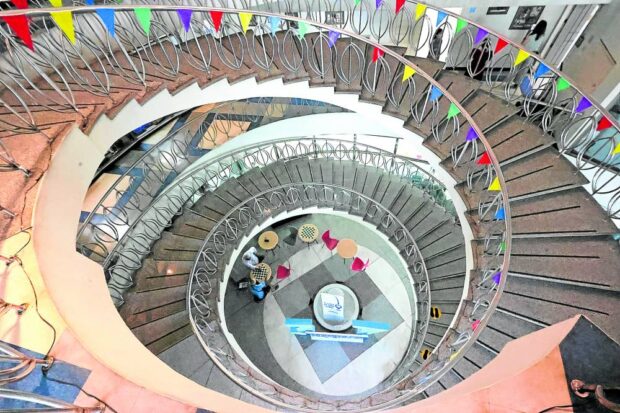
The main stairwell of the Inquirer. (Photo by GRIG C. MONTEGRANDE / Philippine Daily Inquirer)
Of course, no office is without its ghost stories and the Inquirer Building is no different. In this case, it was the fourth floor that somehow just gave people the willies. There were folks who literally could not physically set foot there after dark.
Conversely, the office always was known for its epic parties (and raffles), particularly the anniversary bashes on Dec. 9. There were the visitors who got the entire office buzzing: presidents and politicians, celebrities and beauty queens (often posing on the staircase), athletes like Manny Pacquiao and diplomats, like the most recent visitor to the building, US Ambassador MaryKay Carlson — she would turn out to be the last diplomat to visit.
These are the things that copy boy Allan Mortel will miss. Mortel, who has been with the company for 24 years, has always been quicksilver-quick in bringing editors printouts, almost even before they ask for it — like a kind of editorial telepathy. But like the Inquirer itself, he is making a big move.
Now, the Inquirer Building’s time on Chino Roces has passed. Perhaps the process started on March 13, 2020, the last time the building was fully staffed with over 300 employees. But with the lockdown, the building stood virtually empty for three years and, thanks to an effective content management system (CMS), the paper continued to come out even as the organization worked remotely. Even as the lockdown was gradually lifted, only 30 percent of the workforce worked daily in the office.
The peeling paint on the building’s exterior and the silence in the building were signs of what was coming.
On July 7, it was announced that the Inquirer would be moving to the Media Resource Plaza (MRP) Building on Mola Street corner Pasong Tirad, several blocks away, a building that also houses Inquirer.net and Inquirer Megamobile. The move is aimed at streamlining costs and operations as well as aligning the newspaper with its affiliate companies.
The editorial group has long moved out and will continue to operate on a remote or hybrid basis. There are advantages to this, according to Contreras: “Since PDI is no longer physically separated from other Inquirer Group of Companies units, we can expect easier coordination among their editorial and business teams whenever there are shared, multi-platform projects and closer camaraderie among the staff.”
Unlike in the old building, there will be no permanent cubicles or offices, only communal workspaces where employees can bring and plug in their laptops to work. The support, IT, and business groups will move to the new building on Sept. 1. On Oct. 1, the Inquirer will be operating out of MRP and the old building will belong to a new owner.
Legacy and family
There is much nostalgia as even former employees have made “pilgrimages” to reminisce and take photos one last time. There will be two notable items that will make the move to the new office.
In the middle of the old newsroom is a big, round wooden table. It used to be a dining table at Madrid Restaurant, Inquirer’s second home. This table was where LJM and the top editors discussed scoops and crises. It has stayed with editorial through different offices over three decades and will be part of this move as well in the fourth decade.
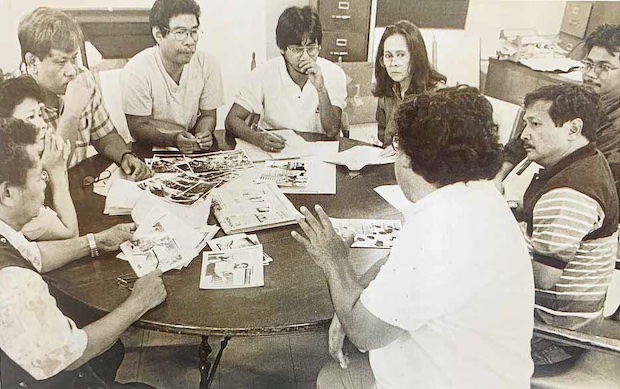
Inquirer editors in the early ’90s met and discussed the next day’s headlines on a round dining table (bottom) that followed the paper through three decades of transfer into several offices. (INQUIRER FILE PHOTO)
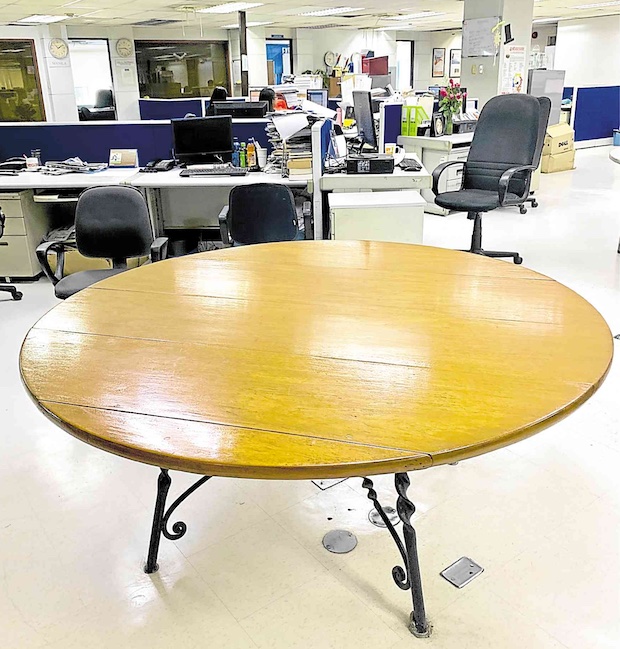
The big, round wooden table from the early days of the paper will also make the move to the newer building. (INQUIRER FILE PHOTO)
In the lobby of the Inquirer Building is a colorful statue in a glass case. This is one of 20 statues of Guyito, the Inquirer’s mascot, created by artist Jess Abrera. Originally known only as Kalabaw, the carabao character would issue pithy one-liners in Abrera’s long-running “A.Lipin” comic strip until he became a distinctive character named “Guyito” (Tagalog for “baby carabao), the winning entry in a naming contest.
For the Inquirer’s 20th anniversary in 2005, the company commissioned 20 statues of Guyito to be painted by 20 of the country’s top artists to be sent to schools around the country save one. The Guyito in the lobby is by sculptor Juan Sajid Imao. Like the staircase, the Guyito is a favorite selfie spot for visitors. Unlike the staircase, Imao’s Guyito will also be making the move to MRP.
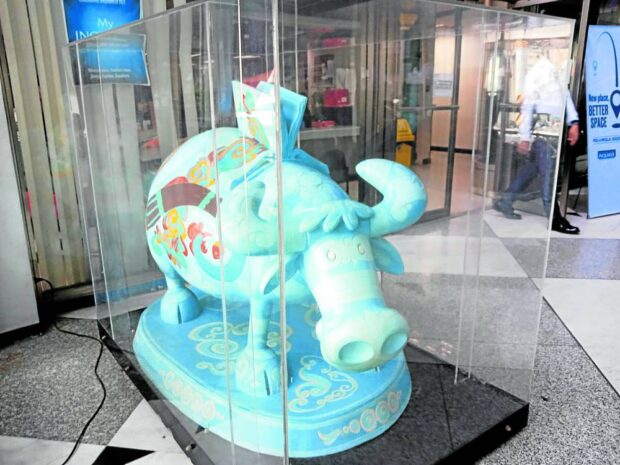
The Guyito statue by Juan Sajid Imao. (Photo by MARY GRACE PAGULAYAN)
But there is now what employees past and present cannot take with them. Javellana feels the weight of what is being lost with this move: “This building is part of the paper’s soul having witnessed the blood, sweat, and tears by the PDI’s entire team to produce excellent journalism and outstanding coverage of events that shaped our nation for almost three decades. It witnessed so much history—the paper’s growth from one platform (print) to different platforms, when we modernized the production of the paper (from the old manual method), when we first printed in color at the turn of the century, and when we marked our career growth from reporters to editors to executives, etc. I will remember it for it is where generations of reporters learned what it takes to be a courageous journalist from the giants in our ranks. I will miss the imposing presence and symbolism of the building which to me, was a proud monument to the Inquirer’s endurance as the country’s most credible paper and newspaper of record.”
Way of life
There are those who are hopeful, even those who have never known any other Inquirer office save the one on Chino Roces.
“It’s hard to say goodbye to the office,” Subingsibing says.
“It’s not the only thing we’re leaving behind, after all — it’s a whole way of life, so to speak, the idea of a physical newsroom where journalism is made, ideas are exchanged and careers are built. I would be one of the first people to defend the value of working from home, but seeing it like a ghost town in the past three years was really heartbreaking. But I’m also certain the Inquirer’s legacy outlives a mere building. It would be interesting to see what comes out of it and how we would form new memories with our new home.”
Leave it to someone who has seen it all — all the Inquirer offices — to put this move in perspective.
“The Inquirer people — journalists, editorial and corporate staff, ad people, security and maintenance personnel, union members— spent some 28 years in this building that went through storms, floods, climate change, politically induced ad boycotts and everything else that life presented,” says Doyo.
“In the Inquirer premises bloomed romances that progressed into weddings, partnerships, and new families. We celebrated milestones, mourned deaths, we bade welcome to new members of the Inquirer, but not really goodbye to those who moved on to other endeavors.
“Those who, still with their boots on and pen in hand, moved on to the next life, LJM among them, we will remember even after the Inquirer offices have moved to another part of town, an imminent move that brings some to near tears. Some have braved the threshold and done their last memory walk, with LJM’s room included in the itinerary.”
Doyo concludes, “Building-wise, there is no forever, but we will always be family.”